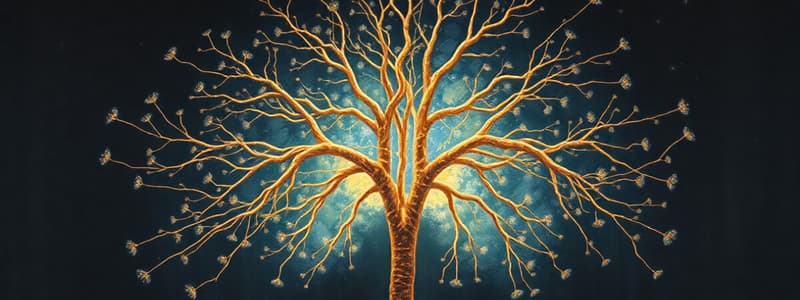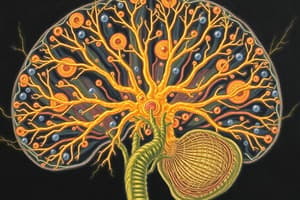Podcast
Questions and Answers
What is the main function of sensory neurons?
What is the main function of sensory neurons?
- To connect one neuron to another within the brain
- To maintain resting potential in the neuron
- To transmit sensory information to the brain (correct)
- To carry commands to muscles and organs
Which term describes the electrical charge difference between the inside and outside of a neuron at rest?
Which term describes the electrical charge difference between the inside and outside of a neuron at rest?
- Action potential
- Resting potential (correct)
- Polarization
- Neuronal threshold
What role does electrostatic pressure play in ion movement?
What role does electrostatic pressure play in ion movement?
- It repels oppositely charged ions
- It attracts similar charged ions
- It pushes ions toward less concentrated areas
- It attracts oppositely charged ions (correct)
Which type of neuron connects one neuron to another in the same part of the brain or spinal cord?
Which type of neuron connects one neuron to another in the same part of the brain or spinal cord?
What causes the movement of ions across a cell membrane?
What causes the movement of ions across a cell membrane?
What effect does an agonist drug have at a receptor?
What effect does an agonist drug have at a receptor?
Which of the following neurotransmitter effects results in a hyperpolarization of the postsynaptic neuron?
Which of the following neurotransmitter effects results in a hyperpolarization of the postsynaptic neuron?
What is the main distinction between spatial summation and temporal summation?
What is the main distinction between spatial summation and temporal summation?
What role does the sympathetic nervous system primarily serve?
What role does the sympathetic nervous system primarily serve?
In the context of the central nervous system, what does the term 'afferent' refer to?
In the context of the central nervous system, what does the term 'afferent' refer to?
Which of these terms describes a bundle of axons in the central nervous system?
Which of these terms describes a bundle of axons in the central nervous system?
What type of voltage change does excitatory postsynaptic potential (EPSP) produce?
What type of voltage change does excitatory postsynaptic potential (EPSP) produce?
What distinguishes an antagonist drug from an agonist drug?
What distinguishes an antagonist drug from an agonist drug?
What is the primary function of the sodium-potassium pump?
What is the primary function of the sodium-potassium pump?
What differentiates chemically gated ion channels from electrically gated ion channels?
What differentiates chemically gated ion channels from electrically gated ion channels?
What is meant by the all-or-none law regarding action potentials?
What is meant by the all-or-none law regarding action potentials?
During which period is it impossible for a new action potential to occur?
During which period is it impossible for a new action potential to occur?
How does the myelin sheath affect the transmission of nerve impulses?
How does the myelin sheath affect the transmission of nerve impulses?
What role do neurotransmitters play in the synapse?
What role do neurotransmitters play in the synapse?
What is a primary characteristic of local potentials?
What is a primary characteristic of local potentials?
What arises during hyperpolarization of a neuron's membrane?
What arises during hyperpolarization of a neuron's membrane?
In the context of neural signaling, what does the rate law describe?
In the context of neural signaling, what does the rate law describe?
What is the primary function of Transcranial Magnetic Stimulation (TMS)?
What is the primary function of Transcranial Magnetic Stimulation (TMS)?
What determines the absorption of X-rays in a CT scan?
What determines the absorption of X-rays in a CT scan?
Which brain structure is primarily involved in regulating hunger and temperature control?
Which brain structure is primarily involved in regulating hunger and temperature control?
What type of imaging does Diffusion Tensor Imaging (DTI) utilize?
What type of imaging does Diffusion Tensor Imaging (DTI) utilize?
Which part of the brain is responsible for fine motor control and procedural memory?
Which part of the brain is responsible for fine motor control and procedural memory?
What does functional Magnetic Resonance Imaging (fMRI) primarily measure?
What does functional Magnetic Resonance Imaging (fMRI) primarily measure?
What type of information is relayed by the thalamus?
What type of information is relayed by the thalamus?
What roles do the caudate nucleus and putamen play in the brain?
What roles do the caudate nucleus and putamen play in the brain?
Which part of the brain helps regulate awareness and attention by filtering irrelevant stimuli?
Which part of the brain helps regulate awareness and attention by filtering irrelevant stimuli?
What physiological process does Electroencephalography (EEG) primarily measure?
What physiological process does Electroencephalography (EEG) primarily measure?
Which lobe of the brain is primarily associated with auditory processing and memory?
Which lobe of the brain is primarily associated with auditory processing and memory?
What response is primarily associated with the amygdala during emotional processing?
What response is primarily associated with the amygdala during emotional processing?
Which of the following describes the primary role of the hypothalamus?
Which of the following describes the primary role of the hypothalamus?
Study Notes
Neurons
- Neurons are specialized cells that transmit sensory information, process data within the CNS, and relay commands to muscles and organs.
- Types of neurons:
- Motor neurons: transmit commands to muscles and organs.
- Sensory neurons: carry information from the body and environment to the brain and spinal cord.
- Interneurons: connect neurons within the CNS, facilitating communication.
Cell Membrane and Ion Movement
- Polarization refers to the electrical charge difference across the neuron's membrane, critical for action potentials.
- Resting potential: the steady state of difference in charge when a neuron is inactive.
- Ions (Na+, K+, Cl-, A-) influence neuron activity through:
- Force of diffusion: movement from areas of high to low concentration.
- Electrostatic pressure: attraction to opposite charges and repulsion from similar charges.
- The sodium-potassium pump maintains ion balance, moving sodium out and potassium into the cell.
Action Potential
- Depolarization occurs when the membrane potential becomes less negative, potentially triggering an action potential.
- Action potential follows an all-or-none law and is nondecremental, maintaining strength as it travels down the axon.
- Hyperpolarization is an increase in charge inside the neuron, often due to chloride influx or potassium efflux.
Synapse and Neurotransmission
- Synapses are fluid-filled gaps between neurons where neurotransmission occurs.
- Neurotransmitters are chemicals that transmit signals across the synapse, influencing the firing of postsynaptic neurons.
- Excitatory postsynaptic potentials (EPSPs) and inhibitory postsynaptic potentials (IPSPs) alter neuron firing probabilities.
- Drugs can act as agonists (enhancing receptor activity) or antagonists (reducing receptor activity).
Organization of the Nervous System
- The nervous system is divided into the Central Nervous System (CNS) and Peripheral Nervous System (PNS).
- CNS comprises the brain and spinal cord; PNS includes all nerves outside the CNS.
- The PNS is further divided into the somatic nervous system (voluntary functions) and autonomic nervous system (involuntary functions).
- In the CNS, afferent pathways carry signals toward the brain while efferent pathways transmit signals from the brain.
Brain Structure
- The brain consists of three primary regions:
- Hindbrain: controls vital functions and movement coordination.
- Midbrain: oversees reflex actions and voluntary movements.
- Forebrain: involved in complex cognitive functions and processes.
Key Brain Components
- Medulla: regulates heart rate, circulation, and respiration.
- Pons: relays signals and coordinates functions between various brain levels.
- Cerebellum: important for balance, coordination, and procedural memory (motor skills).
- Thalamus: acts as a sensory information relay station and filters sensory data.
- Hypothalamus: regulates autonomic functions, hormone secretion, and homeostasis.
Hemispheric Lateralization
- Each brain hemisphere specializes in different functions:
- Right Hemisphere: associated with emotions, intuition, aesthetics, and nonverbal processing.
- Left Hemisphere: involved in analytical thinking, verbal communication, and logic.
- The corpus callosum is the brain structure that connects and facilitates communication between the two hemispheres.
Endocrine System
- Comprises glands that release hormones, acting as a secondary control system for body functions.
- Major glands:
- Pituitary: known as the “director” of hormonal regulation.
- Thyroid: regulates metabolic rate.
- Adrenal: involved in metabolism of salts and carbohydrates.
- Pancreas: manages blood sugar levels.
- The hypothalamus integrates the nervous and endocrine systems, controlling hormone release.
Research Techniques in Neuroscience
- Various methods are used to study brain function:
- CT (Computed Tomography): provides 2D images of the brain using X-rays.
- MRI (Magnetic Resonance Imaging): offers high-resolution images of brain soft tissues using magnetic fields.
- fMRI (Functional MRI): measures brain activity by detecting changes in blood flow.
- PET (Positron Emission Tomography): tracks radioactive compounds in the bloodstream to visualize active brain areas.
- EEG (Electroencephalography): records electrical activity via electrodes, providing excellent temporal resolution.
Important Concepts
- Plasticity: the brain’s ability to form new connections and adapt after injuries.
- Aphasia: a language disorder affecting processing and production.
- Mirror neurons: involved in understanding others' actions and intentions.
Studying That Suits You
Use AI to generate personalized quizzes and flashcards to suit your learning preferences.
Related Documents
Description
This quiz focuses on Chapter 3 of the psychology textbook, which explores the biological component of the nervous and endocrine systems. It covers topics such as neuron structure, electrical and chemical signal transmission, and hemispheric lateralization. Test your understanding of the fundamental concepts surrounding how our body communicates at a cellular level.




